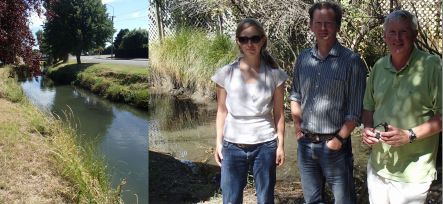By Alison Ballance

The main Heathcote River (left) recovered surprisingly quickly after millions of litres of raw sewage poured into it following the February 2012 earthquake, whereas the small tributary stream (right) remains full of liquefaction sediment and is unlikely to recover on its own. From left: Naomi Wells, Tim Clough and Jon Harding (images: A. Ballance)
After the February 2011 Christchurch earthquake millions of litres of raw sewage – along with lots of liquefaction – poured into the Avon and Heathcote Rivers. A team of biologists quickly got to work to measure the impact of this catastrophe on river life – and they were surprised by what they recorded over the next few months. Alison Ballance joins PhD student Naomi Wells and Tim Clough from Lincoln University, and freshwater ecologist Jon Harding from the University of Cantebrury, at one of their study sites along the Heathcote River, to hear how the river’s microbial communities and fish and invertebrate life responded to the sewage input and then recovered once the sewage was diverted out of the river.
A paper on the research findings is due to be published in the journal Environmental Pollution later this year: Wells NS, Clough TJ, Condron LM, Baisden WT, Harding JS, Dong Y, Lewis GD, Lear G (in revision) Biogeochemistry and community ecology in a spring-fed urban river following a major earthquake.
You can find the Environment of Canterbury report on the state of the rivers after the earthquakes here (pdf).
Our Changing World looked at the impacts of the earthquakes on the Heathcote-Avon estuary with David Schiel from Canterbury University and John Zeldis from NIWA – you can listen to that story here.

